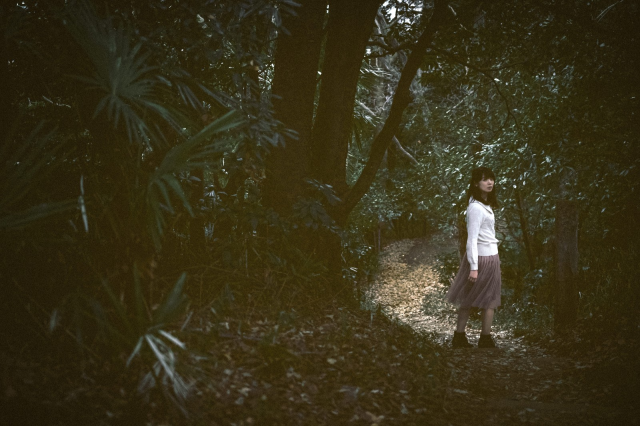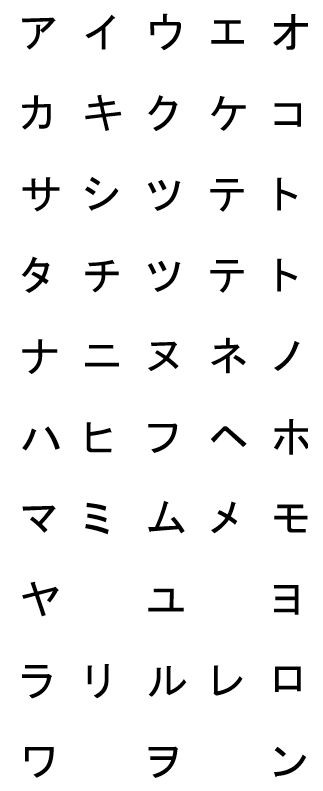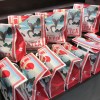
Fan thinks Japanese linguistic stubbornness is limiting the potential audience of Japan’s artists and creators.
You really can’t overstate the massive scale of Comiket, Japan’s twice-a-year gathering of dojinshi (independently published comic) artists. Hundreds of different creative groups participate in the multi-day market, and with most being small organizations without big marketing budgets, it’s generally up to shoppers themselves to find the booths that are selling the items they’re looking for.
To make that process a little easier, Comiket assigns location codes to each booth inside Tokyo Big Site, the event’s convention center venue. But while that system works reasonably well for Japanese fans, the codes have a major shortcoming when it comes to helping foreign otaku, as pointed out by bilingual Japanese Twitter user Rich Mikan (@richmikan).
I noticed a significant problem with Comic Market. That is "KANA," which are the Japanese alphabets, are used to identify exhibitor locations.
— Rich Mikan (@richmikan) January 11, 2020
Foreigners who don't know Japanese can't read them. And, they also don't know the alphabet order, which is needed to seek exhibitors.
Rich Mikan became aware of the situation when he was talking to a foreign Comiket shopper who was looking for a certain group’s booth, which Rich Mikan knew the code for. Booth codes consist of a phonetic kana character, a number, and a Latin alphabet letter. In this case the code was ヨ46a, and that ヨ, read as “yo,” was a major communication roadblock for the foreign fan.
But ヨ isn’t that complicated a symbol, and if a helpful Japanese person jotted it down for you, you’d be able to easily find the booth without any other language skills, right? Not necessarily. The “alphabetic order” for Japanese isn’t the same as the one English uses. Instead, Japanese words/kana are ordered through a combination of their initial consonant and terminal vowel sound. For example, ヨ/yo comes after ユ/yu and before ラ/ra, so unless know both how to read kana and their order, having the booth’s code probably isn’t going to be enough to navigate the Comiket floor.
▼ Turn back if you notice the vegetation starting to get especially thick.
It seems like a multi-segmented, purely numeric code, or one that uses only numbers and Latin letters, would be more broadly understood, considering that the average Japanese person’s understanding of the Latin alphabet/alphabetic order is much stronger than the average foreigner’s grasp of the corresponding kana concepts. However, Rich Mikan’s observation of Comiket’s current code protocol’s potential problems wasn’t met with much sympathy when he tweeted about it in Japanese, which resulted in responses including:
“Even if there are a lot of foreigners who come to Comiket, it’s still and event that’s being held in Japan.”
“If people are going to come to Japan, I want them to learn Japanese.”
“If they can’t read kana, they’ll just have to take searching by trial and error as part of the fun of the event, and if they can’t, they’ll just have to learn how to read them, or find someone who can give them directions without using the code.”
“Pretty much all the dojinshi sold at Comiket are in Japanese, so if someone can’t read Japanese, there’s really not much point in coming to Comiket, is there?”
Setting aside the gap in logic from the last comment (a lot of shoppers at Comiket because they like the medium’s artwork, even without understanding the dialogue and story), this might seem like a cold response from a country that prides itself on customer service and hospitality, but it could have something to do with the fact that for some time Comiket’s exhibitors have firmly held that the shoppers aren’t customers, but simply fans participating in an event. That attitude may have been born out of a necessity to present the event in as non-commercial a way as possible, since a huge portion of the items sold at Comiket make unlicensed use of copyrighted anime/manga characters, with the industry turning a blind eye to the practice as long as creators are of “amateur” status and produce their work in small batches.
That atmosphere also means, though, that Comiket doesn’t always operate under the prevailing Japanese business wisdom that the customer is always right and must be accommodated in every way. So even as Rich Mikan lamented later in the thread that language barriers are a severe limiting factor for the works of Japanese artists, it won’t be a surprise if Comiket sticks with its current booth code system for some time to come…
…so here’s a kana order chart (start at the left, proceed to the right, and then drop down to the next line) in case you’re still learning Japanese, or just at Comiket for the visual appeal.
Source: Twitter/@richmikan (1, 2) via Hachima Kiko
Top image: Pakutaso
Insert images: Pakutaso, SoraNews24
● Want to hear about SoraNews24’s latest articles as soon as they’re published? Follow us on Facebook and Twitter!
Follow Casey on Twitter, where he learned how to read the kana バ to make it easier for him to look for Bubblegum Crisis soundtrack CDs.



 Virtual dojinshi convention Comic Vket recreates the community joy of canceled otaku gatherings
Virtual dojinshi convention Comic Vket recreates the community joy of canceled otaku gatherings Comiket returns! Japan’s largest otaku convention announced for 2021 with new admission policies
Comiket returns! Japan’s largest otaku convention announced for 2021 with new admission policies Comiket will require proof of coronavirus vaccination or PCR test results for admission
Comiket will require proof of coronavirus vaccination or PCR test results for admission Free anti-embarrassment bags to be handed out at Comiket
Free anti-embarrassment bags to be handed out at Comiket Japanese Twitter user reveals why taxi drivers flock to Big Sight during Comiket
Japanese Twitter user reveals why taxi drivers flock to Big Sight during Comiket Foreigner’s request for help in Tokyo makes us sad for the state of society
Foreigner’s request for help in Tokyo makes us sad for the state of society Seaside scenery, history, and so many desserts on Yokohama’s Akai Kutsu【Japan Loop Buses】
Seaside scenery, history, and so many desserts on Yokohama’s Akai Kutsu【Japan Loop Buses】 Red light district sushi restaurant in Tokyo shows us just how wrong we were about it
Red light district sushi restaurant in Tokyo shows us just how wrong we were about it Should you add tartar sauce to Japanese curry rice? CoCo Ichi makes diners an unusual offer
Should you add tartar sauce to Japanese curry rice? CoCo Ichi makes diners an unusual offer Mikado Coffee is a 76-year-old coffee chain with a major celebrity connection
Mikado Coffee is a 76-year-old coffee chain with a major celebrity connection New sushi restaurant hidden inside Tokyo Station is a secret gem
New sushi restaurant hidden inside Tokyo Station is a secret gem Japanese city loses residents’ personal data, which was on paper being transported on a windy day
Japanese city loses residents’ personal data, which was on paper being transported on a windy day Do Hi-Chew-flavor Hi-Chews have a reason to exist?【Taste test】
Do Hi-Chew-flavor Hi-Chews have a reason to exist?【Taste test】 Japan’s summertime towelket pillowcases are even better with the addition of Ghibli stars【Photos】
Japan’s summertime towelket pillowcases are even better with the addition of Ghibli stars【Photos】 This lucky bag stuffed with green tea made us feel like real adults for once
This lucky bag stuffed with green tea made us feel like real adults for once McDonald’s new Happy Meals offer up cute and practical Sanrio lifestyle goods
McDonald’s new Happy Meals offer up cute and practical Sanrio lifestyle goods Japanese ramen restaurants under pressure from new yen banknotes
Japanese ramen restaurants under pressure from new yen banknotes French Fries Bread in Tokyo’s Shibuya becomes a hit on social media
French Fries Bread in Tokyo’s Shibuya becomes a hit on social media New private rooms on Tokaido Shinkansen change the way we travel from Tokyo to Kyoto
New private rooms on Tokaido Shinkansen change the way we travel from Tokyo to Kyoto Tokyo Tsukiji fish market site to be redeveloped with 50,000-seat stadium, hotel, shopping center
Tokyo Tsukiji fish market site to be redeveloped with 50,000-seat stadium, hotel, shopping center Beautiful Ghibli sealing wax kits let you create accessories and elegant letter decorations【Pics】
Beautiful Ghibli sealing wax kits let you create accessories and elegant letter decorations【Pics】 Secret Kitchen bento serves Japanese flowers, birds, wind and moon in a box, but is it worth it?
Secret Kitchen bento serves Japanese flowers, birds, wind and moon in a box, but is it worth it? New definition of “Japanese whiskey” goes into effect to prevent fakes from fooling overseas buyers
New definition of “Japanese whiskey” goes into effect to prevent fakes from fooling overseas buyers Our Japanese reporter visits Costco in the U.S., finds super American and very Japanese things
Our Japanese reporter visits Costco in the U.S., finds super American and very Japanese things Studio Ghibli releases Kiki’s Delivery Service chocolate cake pouches in Japan
Studio Ghibli releases Kiki’s Delivery Service chocolate cake pouches in Japan All-you-can-drink Starbucks and amazing views part of Tokyo’s new 170 meter-high sky lounge
All-you-can-drink Starbucks and amazing views part of Tokyo’s new 170 meter-high sky lounge More foreign tourists than ever before in history visited Japan last month
More foreign tourists than ever before in history visited Japan last month New Pokémon cakes let you eat your way through Pikachu and all the Eevee evolutions
New Pokémon cakes let you eat your way through Pikachu and all the Eevee evolutions Disney princesses get official manga makeovers for Manga Princess Cafe opening in Tokyo
Disney princesses get official manga makeovers for Manga Princess Cafe opening in Tokyo Sales of Japan’s most convenient train ticket/shopping payment cards suspended indefinitely
Sales of Japan’s most convenient train ticket/shopping payment cards suspended indefinitely Sold-out Studio Ghibli desktop humidifiers are back so Totoro can help you through the dry season
Sold-out Studio Ghibli desktop humidifiers are back so Totoro can help you through the dry season Japanese government to make first change to romanization spelling rules since the 1950s
Japanese government to make first change to romanization spelling rules since the 1950s Ghibli founders Toshio Suzuki and Hayao Miyazaki contribute to Japanese whisky Totoro label design
Ghibli founders Toshio Suzuki and Hayao Miyazaki contribute to Japanese whisky Totoro label design Doraemon found buried at sea as scene from 1993 anime becomes real life【Photos】
Doraemon found buried at sea as scene from 1993 anime becomes real life【Photos】 Tokyo’s most famous Starbucks is closed
Tokyo’s most famous Starbucks is closed One Piece characters’ nationalities revealed, but fans have mixed opinions
One Piece characters’ nationalities revealed, but fans have mixed opinions We asked a Uniqlo employee what four things we should buy and their suggestions didn’t disappoint
We asked a Uniqlo employee what four things we should buy and their suggestions didn’t disappoint The cosplay of Comiket 88: Sailor Moon, Splatoon, Love Live! and more【Photos】
The cosplay of Comiket 88: Sailor Moon, Splatoon, Love Live! and more【Photos】 Tokyo train station and convenience store roll out otaku welcome for Comiket attendees 【Photos】
Tokyo train station and convenience store roll out otaku welcome for Comiket attendees 【Photos】 The best cosplayers of Day 1 of Winter Comiket 2021【Photos】
The best cosplayers of Day 1 of Winter Comiket 2021【Photos】 Tokyo politician creates dojinshi manga, will be at Comiket selling it
Tokyo politician creates dojinshi manga, will be at Comiket selling it Return of Comiket doujinshi manga convention announced for 2021 in Tokyo
Return of Comiket doujinshi manga convention announced for 2021 in Tokyo The beautiful cosplayers of summer Comiket 2018【Photos】
The beautiful cosplayers of summer Comiket 2018【Photos】 Mandarin orange peels aren’t trash, they’re treasure! Three chimpi tips to reuse your mikan skins
Mandarin orange peels aren’t trash, they’re treasure! Three chimpi tips to reuse your mikan skins Comiket for beginners: 7 tips for surviving Summer Comic Market
Comiket for beginners: 7 tips for surviving Summer Comic Market Biannual Comiket otaku migration attracts a predator for the first time 【Video】
Biannual Comiket otaku migration attracts a predator for the first time 【Video】 Cosplayer wows Comiket attendees with sake bottle cosplay from hit anime Your Name
Cosplayer wows Comiket attendees with sake bottle cosplay from hit anime Your Name A massive photo collection of the coolest anime figures from Winter Wonder Festival
A massive photo collection of the coolest anime figures from Winter Wonder Festival The best Japanese cosplayers from Day 1 of Summer Comiket 2019【Photos】
The best Japanese cosplayers from Day 1 of Summer Comiket 2019【Photos】 Station and Lawson convenience store near Tokyo Big Sight gear up for a blazing Summer Comiket
Station and Lawson convenience store near Tokyo Big Sight gear up for a blazing Summer Comiket Japan’s number one cosplayer attracts jaw-dropping crowds at Summer Comiket
Japan’s number one cosplayer attracts jaw-dropping crowds at Summer Comiket
Leave a Reply